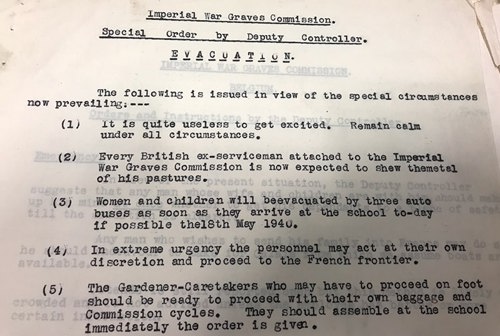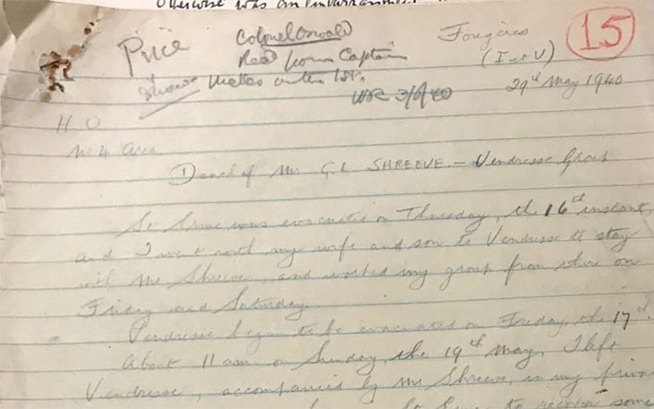28 May 2020
Commission Staff and the Dunkirk Evacuation of 1940
At the outbreak of the Second World War, Commission staff who were caring for the cemeteries and memorials in Western Europe were suddenly faced with an advancing enemy army. Here, Historian and Harvard University Lecturer, Caitlin Galante-DeAngelis Hopkins explores some of the stories of the Commission staff who formed a small part of the Dunkirk evacuation.
 In December of 2019, I travelled to Hastings to interview Marcel Hayler, the son of War Graves Commission gardener Henry Hayler. Like most early Commission gardeners, Henry had served in the First World War and stayed in France to tend the graves of his fallen comrades. Marcel was born in France in 1929 and grew up in Aubers, where his father was the caretaker of Aubers Ridge British Cemetery. He shared many memories with me, recalling his childhood trips to the Menin Gate and his father’s pride in attending the dedication of the Vimy Memorial in 1936.
In December of 2019, I travelled to Hastings to interview Marcel Hayler, the son of War Graves Commission gardener Henry Hayler. Like most early Commission gardeners, Henry had served in the First World War and stayed in France to tend the graves of his fallen comrades. Marcel was born in France in 1929 and grew up in Aubers, where his father was the caretaker of Aubers Ridge British Cemetery. He shared many memories with me, recalling his childhood trips to the Menin Gate and his father’s pride in attending the dedication of the Vimy Memorial in 1936.
Among those happier memories, Marcel also spoke of the events of May 1940, when his family fled their home during the Nazi invasion of France. While British soldiers evacuated from Dunkirk, British civilians like the Haylers had to flee on their own. Marcel’s father was “reluctant to leave as he had not received a directive to evacuate,” but as the Germans advanced, the Haylers decided that they could not wait for orders. Marcel and his brother Ernest freed their pet rabbits and piled into the family’s 1937 Peugeot. They stopped in nearby Laventie to pick up another Commission family and attempted to follow the retreating British troops to Dunkirk, but were turned away and redirected to Boulogne. There, they were allowed to board the SS St. Julien, a Red Cross hospital ship that delivered them safely to Southampton.
The Haylers were not the only Commission family to make a narrow escape. When the Germans invaded Belgium on May 10, 1940, the Commission employed over 500 staff along the old Western Front. Nearly all of them were British and Commonwealth nationals who faced arrest if they were captured by the Nazis. On the eightieth anniversary of the evacuation, some of their stories are preserved in the CWGC Archives in Maidenhead.
On May 18, Captain Reginald Haworth, head of the Commission’s Belgian office, directed his men to bring their families to pre-arranged assembly points in Ypres and Poperinghe so that they could leave Belgium together. “It is quite useless to get excited,” he wrote in a circular letter announcing the withdrawal. “Remain calm under all circumstances. Every British ex-serviceman attached to the Imperial War Graves Commission is now expected to shew the metal [sic] of his pastures.” Under Haworth’s leadership, the vast majority of the 133 gardeners from the Ypres area were evacuated safely before Belgium surrendered to the Germans.

“EVACUATION” circular letter, 17 May 1940, CWGC/1/1/B/76
Things were different in France. In Belgium, most of the IWGC staff lived in a relatively concentrated area around Ypres, but in France, they were scattered in cities and villages from Reims to Calais. Brigadier John Mervyn Prower, the Chief Administrative Officer in France, ordered the gardeners to stay at their posts unless ordered to evacuate by civil authorities.
 Thus, many of the Commission’s staff were still at work when German forces arrived. On May 19, the Commission’s Arras office was bombed by the Luftwaffe. “We instinctively dashed for the cellar,” wrote Joseph Gothwaite, an Inspector of Stones and Material. “As we were moving, every window of the office was blown in, doors came off their hinges, splinters struck the internal walls and the whole place was littered with dust, files, and papers in the space of seconds.” The Commission office was located just across from the Arras train station, which had been the main target of the attack. When the dust settled, Nursing Sister Betty Stuart, a member of the Commission’s medical staff, climbed out of the cellar and began providing first aid to the hundreds of wounded, many of whom had been passengers on refugee trains parked at the station. Gothwaite praised Sister Stuart’s “extreme bravery” and marvelled that, “she was as calm and collected as if nothing out of the common had occurred.”
Thus, many of the Commission’s staff were still at work when German forces arrived. On May 19, the Commission’s Arras office was bombed by the Luftwaffe. “We instinctively dashed for the cellar,” wrote Joseph Gothwaite, an Inspector of Stones and Material. “As we were moving, every window of the office was blown in, doors came off their hinges, splinters struck the internal walls and the whole place was littered with dust, files, and papers in the space of seconds.” The Commission office was located just across from the Arras train station, which had been the main target of the attack. When the dust settled, Nursing Sister Betty Stuart, a member of the Commission’s medical staff, climbed out of the cellar and began providing first aid to the hundreds of wounded, many of whom had been passengers on refugee trains parked at the station. Gothwaite praised Sister Stuart’s “extreme bravery” and marvelled that, “she was as calm and collected as if nothing out of the common had occurred.”
Gardener Patrick Egan, his wife Claire, and their seven children were among the civilians evacuated from Dunkirk on the SS St. Helier on May 23. Their three oldest sons, C.W., Alphonsus, and Ambrose, were all employed by the Commission as Pupil Gardeners. In 1941, Alphonsus was killed while serving with the RAF and is commemorated on the Runnymede Memorial. C.W. returned to France after the war and became a Head Gardener.


SS St. Helier evacuation list, 23 May 1940, CWGC/1/1/7/B/77, Account of W.G. Price (#15), 29 May 1940, CWGC 1/1/7/B/78
Not all of the gardeners made it to the coast. On May 19, 56-year-old gardener Leopold Shreeve of Vendresse-Beaulne was riding in a car driven by his friend, gardener W.G. Price, when they encountered a German roadblock near Corbeny. At the sight of German tanks, Price turned the car around, but five soldiers opened fire, striking Shreeve in the stomach. “I think I’m hit,” Shreeve told Price. He bled to death on the way to a French military hospital. He is buried in Vailly-sur-Aisne Communal Cemetery and commemorated on the rolls of the Civilian War Dead of the Second World War.
Tags
IWGC
Second World War
Evacuation


 In December of 2019, I travelled to Hastings to interview Marcel Hayler, the son of War Graves Commission gardener Henry Hayler. Like most early Commission gardeners, Henry had served in the First World War and stayed in France to tend the graves of his fallen comrades. Marcel was born in France in 1929 and grew up in Aubers, where his father was the caretaker of Aubers Ridge British Cemetery. He shared many memories with me, recalling his childhood trips to the Menin Gate and his father’s pride in attending the dedication of the Vimy Memorial in 1936.
In December of 2019, I travelled to Hastings to interview Marcel Hayler, the son of War Graves Commission gardener Henry Hayler. Like most early Commission gardeners, Henry had served in the First World War and stayed in France to tend the graves of his fallen comrades. Marcel was born in France in 1929 and grew up in Aubers, where his father was the caretaker of Aubers Ridge British Cemetery. He shared many memories with me, recalling his childhood trips to the Menin Gate and his father’s pride in attending the dedication of the Vimy Memorial in 1936.
 Thus, many of the Commission’s staff were still at work when German forces arrived. On May 19, the Commission’s Arras office was bombed by the Luftwaffe. “We instinctively dashed for the cellar,” wrote Joseph Gothwaite, an Inspector of Stones and Material. “As we were moving, every window of the office was blown in, doors came off their hinges, splinters struck the internal walls and the whole place was littered with dust, files, and papers in the space of seconds.” The Commission office was located just across from the Arras train station, which had been the main target of the attack. When the dust settled, Nursing Sister Betty Stuart, a member of the Commission’s medical staff, climbed out of the cellar and began providing first aid to the hundreds of wounded, many of whom had been passengers on refugee trains parked at the station. Gothwaite praised Sister Stuart’s “extreme bravery” and marvelled that, “she was as calm and collected as if nothing out of the common had occurred.”
Thus, many of the Commission’s staff were still at work when German forces arrived. On May 19, the Commission’s Arras office was bombed by the Luftwaffe. “We instinctively dashed for the cellar,” wrote Joseph Gothwaite, an Inspector of Stones and Material. “As we were moving, every window of the office was blown in, doors came off their hinges, splinters struck the internal walls and the whole place was littered with dust, files, and papers in the space of seconds.” The Commission office was located just across from the Arras train station, which had been the main target of the attack. When the dust settled, Nursing Sister Betty Stuart, a member of the Commission’s medical staff, climbed out of the cellar and began providing first aid to the hundreds of wounded, many of whom had been passengers on refugee trains parked at the station. Gothwaite praised Sister Stuart’s “extreme bravery” and marvelled that, “she was as calm and collected as if nothing out of the common had occurred.”
